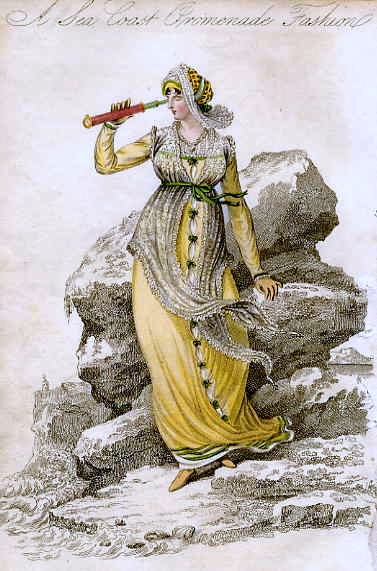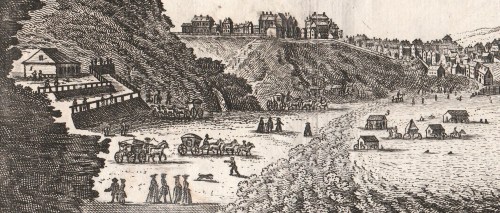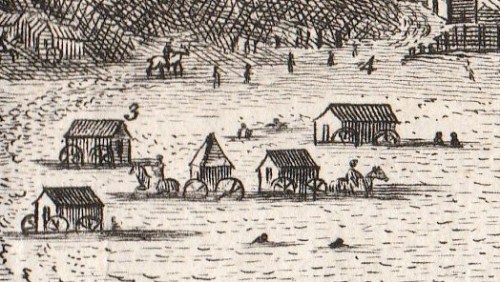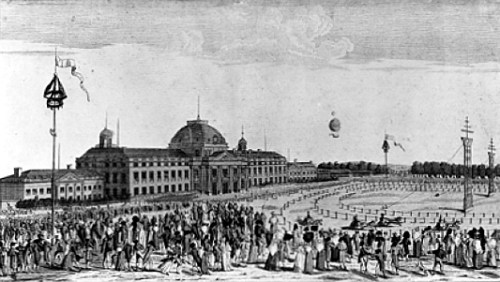August in London was the time to celebrate “Oyster Day” – the arrival of the first oysters at Billingsgate fish market. The scene on the streets is shown in the first print from Crucikshank’s London Almanac. This was a significant day for the poor for whom oysters was a cheap staple. In London Labour and the Poor Mayhew wrote that “the number of oysters sold by the costermongers amounts to 124,000,000 a year. These, at four a penny, would realise the large sum of £129,650. We may, therefore, safely assume that £125,000 is spent yearly in oysters in the streets of London.”

In the scene working people queue up at two trestle tables to buy oysters. The vendors are opening them and on the left we can see a coal heaver or dustman, distinguished by his hat with a protective neck flap, pouring some kind of relish or ketchup over his.
A small boy is rummaging under the trestle for empty shells and on the right one lad is building them into a construction while other children holding up shells mob a respectably-dressed couple begging for coppers. An article in the Illustrated London News of 1851 explains what must be happening.
“We will not pursue the calculation into how many grottoes might be built from the shells of a year’s supply of oysters…. The coming-in of oysters is observed as a sort of festival in the streets; and in such a nook of the metropolis as the present locality, the grotto is usually built of inverted oyster-shells piled up conically with an opening in the base, through which, as night approaches, a lighted candle is placed within the grotto, when the effect of the light through the chinks of the shelly cairn is very pretty. It is but fair that the young architects should be rewarded for their trouble accordingly, a little band, of what some churl may call urchins, sally forth to collect pence from the passers-by ; and the usual form of collecting the tax [is] by presenting a shell…”
Of course, you might choose to leave the heat and dust of London in August (to say nothing of the smell of discarded oyster shells) and go to the seaside. Brighton, Margate and Ramsgate were closest (if one leaves aside Gravesend, which even in the Georgian period was getting a reputation for being somewhat rough).
 Cruikshank has chosen to show bathing machines at Brighton with four burly female “dippers” dunking their quailing customers in the sea. The machines have boards showing the names of the dippers – two for “Mrs Ducks” and one for “Mrs Dipps”. In the foreground a lady is entirely enveloped, head and all, in a flannel “case” while in the middle two dippers are about to plunge a slight figure – a teenage girl perhaps – in backwards. A furious baby is getting a relentless ducking at the far end.
Cruikshank has chosen to show bathing machines at Brighton with four burly female “dippers” dunking their quailing customers in the sea. The machines have boards showing the names of the dippers – two for “Mrs Ducks” and one for “Mrs Dipps”. In the foreground a lady is entirely enveloped, head and all, in a flannel “case” while in the middle two dippers are about to plunge a slight figure – a teenage girl perhaps – in backwards. A furious baby is getting a relentless ducking at the far end.
The Margate design of bathing machine, invented by Quaker Benjamin Beale, had a hood which came down to shelter the bather’s modesty, and perhaps divert some of the force of the waves, but these were not used at Brighton.
Although the seaside holiday is often thought of as a Victorian invention they were very much a feature of the Georgian scene for those who had money and leisure. By 1800 every English county with a coastline had at least one seaside resort. Brighton is perhaps the most famous example, but it was by no means the first – Scarborough probably has best claim to the title, although Margate and Brighton were close behind and all three were flourishing in the 1730s, long before the Prince Regent made Brighton notorious.
Brighton did have the benefit of closeness to London that Scarborough did not. In 1821 Dr John Evans remarked on stagecoaches doing the journey in six hours and predicted that balloon travel would reduce it to four hours in the future and in 1823 Cobbett wrote of “stock-jobbers…[who] skip backwards and forward on the coaches, and actually carry on stock-jobbing, in ‘Change Alley, though they reside in Brighton.” In 1834 four hundred and eight passengers arrived by coach in Brighton in one day, and 50,000 were recorded for the year.
Just as beach-wear and cruise-wear figure in the fashion magazines today, outfits for seaside visits were carefully chosen. Here is one from La Belle Assemblée designed by Mrs Bell for “Sea Coast Promenade”. personally I think the wearer has located the gentlemen’s bathing beach and has no intention of promenading any further…












